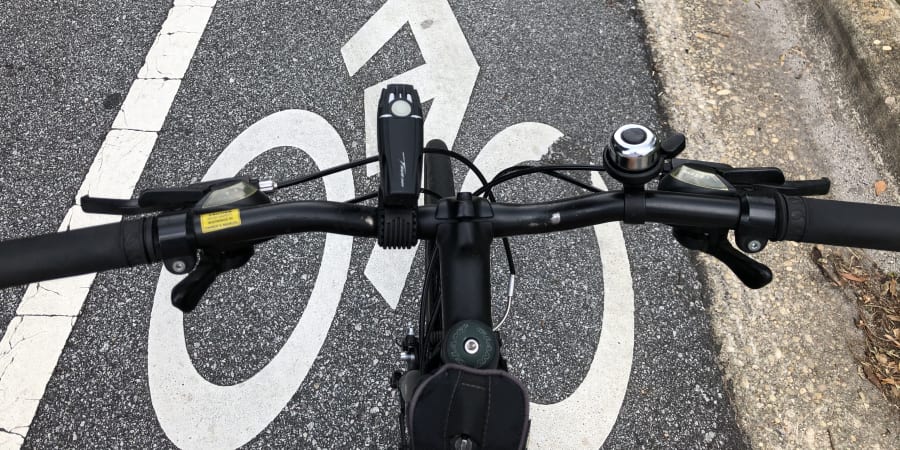
Three modes of bicycle commuting
We all recognize the main bicycle categories, such as mountain biking, BMX, touring, and commuting to name a few. But when we zoom-in to commuting, then the landscape seems less neatly categorized. Even though commuters may collectively use diverse styles of bicycles and equipment, they all seem to do basically the same thing with them. Despite this, I’d argue that commuting works in three basic modes. These modes aren’t based on what kind of gear you use, but in your mindset and behavior.
- Mode one: you ride your bicycle as if you’re walking, but faster.
- Mode two: you ride your bicycle as if you’re running, but faster.
- Mode three: you ride your bicycle as if you’re driving a car, but slower.
Either consciously or unconsciously, you probably fall into one of these modes while you bike commute, or maybe you switch between them. Our transportation system is overwhelmingly designed for mode three. Trail systems are generally designed for mode two. Mode one is usually not a consideration in our towns.
Are any of these superior to the others? Let’s dive a bit deeper into each one’s characteristics.
Mode one: riding a bicycle as if you’re walking, except faster.
Imagine you want to walk somewhere. It could be down the street, across the neighborhood, or anywhere that would normally be a comfortable walk. But even a pleasant walk can be time consuming. With a bicycle, you can turn a 30-minute walk into a 5-minute ride, and you don’t even need to get your heart rate up.
You don’t need any special clothing or gear, besides maybe a basket (because you can’t use your arms while riding). And, by no gear, I do indeed mean no helmet too. If that seems scandalous, do you wear a helmet to walk down the street?
Mode two: riding a bicycle as if you’re running, except faster.
If you commute on trails or bike paths, then this may sound familiar. You do a bit of extra prep before leaving, possibly putting on workout clothes and packing an outfit for changing. You know you will break a sweat before you get to your destination.
This mode puts more importance on the gear. You will certainly wear a helmet. And even if you don’t have the fastest racing bicycle, you want to make sure your bicycle is well maintained.
Mode three: riding a bicycle as if you’re driving a car, except slower.
Once you leave your neighborhood, then this mode takes over. Legally, this is how you’re “supposed” to ride a bicycle on the street. Most states consider bicycles a type of vehicle and are thus subject to most of the same rules that govern cars.
When you ride in this mode, you always wear a helmet, signal your turns, ride with traffic, “take the lane,” stop at red lights, and wear reflective clothing. It may be necessary, but it’s not very fun.
Which is best?
I don’t believe there’s a “best” or “optimal” mode, only different ones for different situations. However, our transportation system’s overemphasis on mode three has created a toxic environment where the least enjoyable and least accessible mode is forced on us the most.
I don’t want to knock the rules of the road, but most people would rather not be literally a vehicle when they’re on a bicycle. It feels unnatural and dehumanizing to move your body with automobile traffic. It’s also extremely stressful, especially for someone who isn’t accustomed to it. Most people quickly realize that turning yourself into a “car, but slower” means that you might as well just drive a car, because you’ve forfeited all of fun of riding a bicycle.
Have you ever seen someone learn for the first time that they’re not legally allowed to ride on the sidewalk or that they need to ride with traffic? A common reaction is incredulity. However necessary these these laws may be, they certainly make bicycling unappealing.
But mode one, biking as if you’re walking, is a pleasure. There’s no need to stress over if you have the “right” kind of bicycle, what you’re wearing, or what the traffic is like. Of course, this presupposes that you live in a walkable area in the first place, which is not the reality for most of us in the US.
The mobility “food pyramid.”
I’m a huge fan of bicycling, but mainly as long as it goes hand-in-hand with walking. Imagine the food pyramid, but with transportation. I believe that our daily lives should be spent mostly walking (the base of the pyramid), with some bicycling when needed (the middle of the pyramid), and driving cars only occasionally (the tip of the pyramid). Each mode of transportation has its uses, but only walking should occupy most of our time.
When you see bicycle infrastructure around your town, what kind of bicycling is it for? Is it for no-stress, leisurely rides around the neighborhood (mode one)? Or is it for riding in hectic traffic (mode three)? Which kind do you think actually encourages your neighbors to ride their bicycles?
